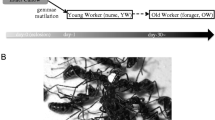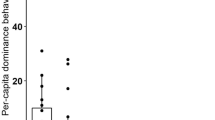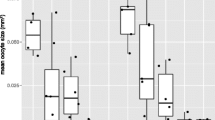Summary
The use of time by workers of the ant Leptothorax allardycei (Mann) is examined. Theoretical predictions are developed concerning the maximal lowering in colony reproductive output that is consistent with the evolution of worker production. Measurements are made of the effect of aggression on colony efficiency. Analysis of time budgets indicate that a typical ant spends a large fraction (0.55) of its time quiescent and another large fraction of time (0.32) involved in undifferentiated activity. Dominance activity and brood care together make up about 11% of the total time. The amount of time spent on dominance activity is negatively related to the amount of time spent on brood care, but positively related to the amount of time that an ant is active. The amount of time that an ant has available for brood care which is actually spent on brood care declines with the amount of time spent on dominance activity. The amount of time that a worker spends feeding liquid food to larvae is a function of hierarchy rank; alpha spends the most time, beta less and gamma still less. The spread of the trait of worker reproduction is examined theoretically, with particular regard to the associated costs to colony reproduction. Worker reproduction can spread through a population, under a variety of formulations, provided the cost to colony reproduction is less than some critical value in the neighborhood of 0.17–0.22 of the total colony output. The cost of worker reproduction in L. allardycei is estimated in two ways: as a time cost and as a reduction in the total number of brood tended per unit time. The two estimates of cost are 0.15 and 0.13 respectively. The reproductive options of the worker caste and the division of reproductive labor vary considerably between species. Reproduction by workers yields fitness differences between workers and results in competition among workers with the result that colony efficiency is affected.
Similar content being viewed by others
References
Abugov R (1981) Non-linear benefits and the evolution of eusociality in the hymenoptera. J Theor Biol 88:733–742
Alexander RD and Sherman PW (1977) Local mate competition and parental investment in social insects. Science 196:494–500
Aoki K, Moody M (1981) One- and two-locus models of the origin of worker behavior in hymenoptera. J Theor Biol 89:449–474
Charnov EL (1978a) Sex ratio selection in eusocial hymenoptera. Am Nat 112: 17–36
Charnov EL (1978b) Evolution of eusocial behavior: Offspring device or parental parasitism? J Theor Biol 75:451–465
Cole BJ (1980) Repertoire convergence in two mangrove ants, Zacryptocerus varians and Camponotus (Colobopsis) sp. Insectes Soc 27:265–275
Cole BJ (1981) Dominance hierarchies in Leptothorax ants. Science 212:83–84
Cole BJ (1983) Assembly of mangrove ant communities: colonization abilities. J Anim Ecol 52:349–355
Craig R (1979) Parental manipulation, in selection and the evolution of altruism. Evolution 33:319–334
Craig R (1980) Sex ratio changes and the evolution of eusociality in the hymenoptera: simulation and game theory studies. J Theor Biol 87:55–70
Franks NR, Scovell E (1983) Dominance and reproductive success among slave-making worker ants. Nature 304:724–725
Hamilton WD (1972) Altruism and related phenomena, mainly in social insects. Annu Rev Ecol Syst 3:193–232
Herbers JM (1983) Social organization in Leptothorax ants: within- and between-species patterns. Psyche 90:361–386
Herbers JM, Cunningham M (1983) Social organization in Leptothorax longispinosus Mayr. Anim Behav 31:775–791
Lindauer M (1978) Communication among social bees. Harvard, Cambridge
Oster GF, Wilson EO (1978) Caste and ecology in the social insects. Princeton Univ Press
Trivers RL, Hare H (1976) Haplodoploidy and the evolution of social insects. Science 191:249–263
Ward PS (1983) Genetic relatedness and colony organization in a species complex of ponerine ants. 1. phenotypic and genotypic composition of colonies. Behav Ecol Sociobiol 12:285–299
West Eberhard MJ (1975) The evolution of social behavior by kin selection. Q Rev Biol 50:1–33
Wilson EO (1980a) Caste and the division of labor in leaf-cutter ants (Hymenoptera: formicidae: Atta). I. The overall pattern. Behav Ecol Sociobiol 7:143–156
Wilson EO (1980b) Caste and division of labor in leaf-cutter ants (Hymenoptera: Formicidae: Atta). II. The ergonomic optimization of leaf cutting. Behav Ecol Sociobiol 7:157–165
Author information
Authors and Affiliations
Rights and permissions
About this article
Cite this article
Cole, B.J. The social behavior of Leptothorax allardycei (Hymenoptera, Formicidae): time budgets and the evolution of worker reproduction. Behav Ecol Sociobiol 18, 165–173 (1986). https://doi.org/10.1007/BF00290820
Received:
Accepted:
Issue Date:
DOI: https://doi.org/10.1007/BF00290820




